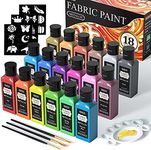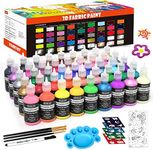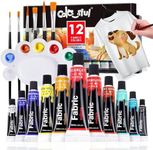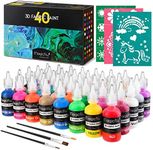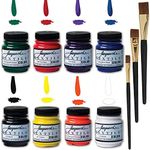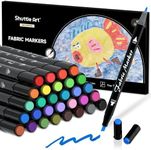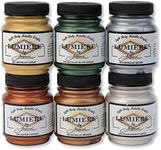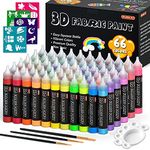Buying Guide for the Best Fabric Paints
Choosing the right fabric paint can make a big difference in how your project turns out, whether you're decorating a t-shirt, personalizing a tote bag, or working on a larger textile art piece. The best fabric paint for you depends on the type of fabric you're using, the look you want to achieve, and how you want your finished piece to feel and last. Understanding the key features of fabric paints will help you make a choice that matches your creative vision and practical needs.Paint Type (Acrylic, Dye, Ink, Puffy, Spray)Fabric paints come in several types, each offering different effects and uses. Acrylic-based paints are the most common and versatile, suitable for most fabrics and easy to use for beginners. Fabric dyes soak into the fibers and are great for vibrant, long-lasting color, but they often require more steps and are best for larger areas. Fabric inks are thinner and work well for stamping or screen printing. Puffy paints create a raised, textured effect, adding dimension to your designs. Spray paints are good for covering large areas quickly or creating gradient effects. To choose the right type, think about the look and texture you want, the technique you plan to use, and the fabric you’re working with.
Opacity and CoverageOpacity refers to how well the paint covers the fabric and whether the original color of the fabric shows through. Opaque paints are best for painting on dark fabrics or when you want bold, solid colors. Transparent or semi-transparent paints work well on light fabrics or when you want a softer, layered look. If you want your design to stand out on a dark shirt, go for high-opacity paint. For subtle effects or watercolor-like designs, choose paints with lower opacity.
Washability and DurabilityWashability is about how well the paint holds up after washing, which is important if your project will be worn or used regularly. Some paints are designed to be permanent and withstand many washes, while others may fade or wash out over time. Durability also includes resistance to cracking, peeling, or fading from sunlight. If you’re painting clothing or items that will be washed often, look for paints labeled as permanent and machine-washable. For decorative items that won’t be washed, this may be less important.
Finish (Matte, Glossy, Metallic, Glitter)The finish of fabric paint affects how your design looks and feels. Matte finishes are flat and non-shiny, giving a classic look. Glossy finishes reflect light and can make colors appear more vibrant. Metallic and glitter finishes add sparkle and shine, making designs pop. Choose the finish based on the style you want—matte for a subtle look, glossy or metallic for eye-catching effects, and glitter for extra fun or festive projects.
Drying and Curing TimeDrying time is how long it takes for the paint to be touch-dry, while curing time is how long it takes to fully set and become washable. Some paints dry quickly and can be handled within an hour, while others need several hours or even days to cure completely. If you need your project finished quickly, look for fast-drying paints. If you have time and want the most durable result, be patient and follow the recommended curing instructions.
Application Method (Brush, Squeeze Bottle, Spray, Marker)Fabric paints come in different forms for different application methods. Bottles for brushing are versatile and good for detailed work. Squeeze bottles are great for outlining or creating raised lines. Sprays cover large areas or create special effects, while markers are perfect for drawing or writing. Choose the application method that matches your project—detailed designs may need brushes or markers, while large or abstract designs might benefit from sprays or squeeze bottles.
Flexibility and FeelFlexibility refers to how the painted area feels after drying—some paints can make fabric stiff, while others stay soft and flexible. If you want your fabric to remain comfortable to wear or drape naturally, look for paints labeled as soft or flexible. For decorative items where feel isn’t as important, this may not be a concern.
